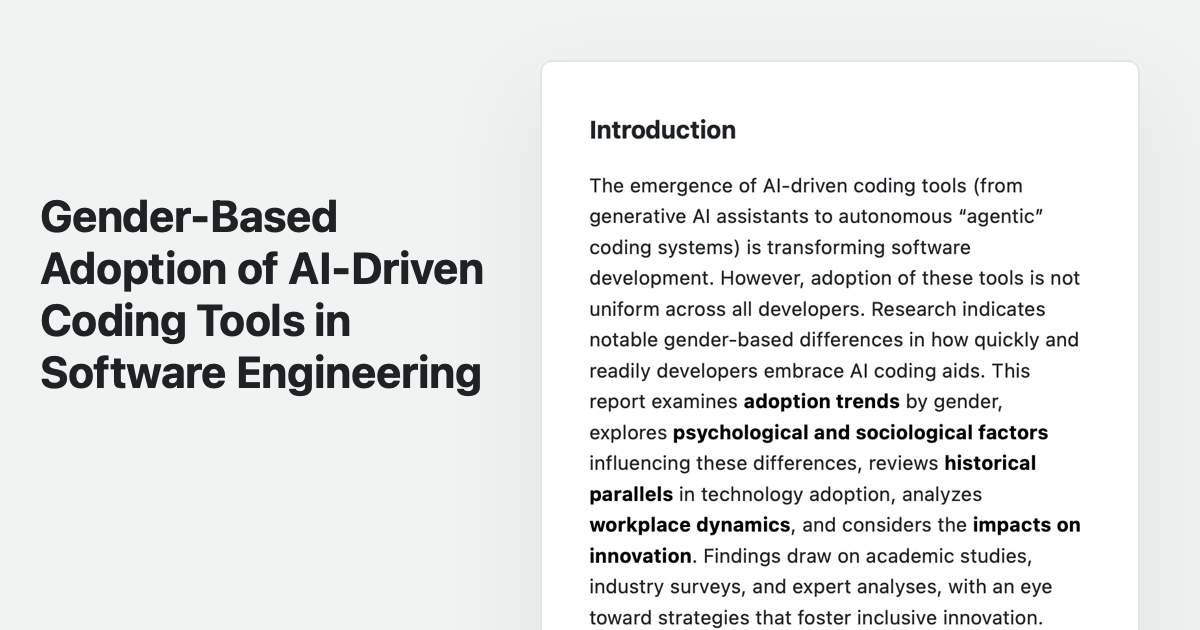Are Women Computer Engineers the First to Face Layoffs?
In the AI revolution, a delicate interplay of bold risk and cautious insight fuels innovation and progress in tech. Now!

Not long ago, Maja and I sat across from a series of software engineers, poised to unravel a mystery that troubled us: the adoption of AI-driven coding workflows. Our question was simple, almost elementary: did they regularly use tools like Cursor, agentic coding, or Vibe coding in their daily engineering practices? The answers, however, were far from straightforward.
Out of ten capable engineers we interviewed, only two actively engaged with generative AI tools. Both were men. Every female engineer in our admittedly small sample hesitated—uncertain, unfamiliar, perhaps wary of the hype surrounding these shiny, promising technologies. It wasn’t mere ignorance; it was hesitation. Maja herself confessed experiencing similar reluctance when first encountering this evolution in coding.
But why? Why were these skilled women, every bit as capable and intelligent as their male counterparts, holding back?
To understand this hesitation, we must consider our ancestral history—our ingrained, subconscious wiring. Picture two prehistoric figures: one, a male hunter stalking prey through unknown territories, and the other, a female gatherer, carefully assessing familiar terrain to ensure safety and sustenance. For the hunter, rapid adaptation to novel tools could mean the difference between eating and starving, survival or extinction. For the gatherer, the careful and cautious accumulation of knowledge, an assessment rooted in familiarity, often proved the safer, smarter strategy.
Research supports the idea of gender differences in adopting new technologies and tools. Studies suggest that men are generally quicker to experiment with novel technologies, while women often exhibit caution, opting for deeper assessment before full engagement. According to a report by the Pew Research Center, men frequently demonstrate greater confidence in their technological skills, often adopting tools earlier due to a combination of social conditioning and perceived risk tolerance. Women, meanwhile, often prioritize comprehensive understanding and evidence of effectiveness before integrating new tools into their practices.
Moreover, studies from the Harvard Business Review indicate that women frequently face greater scrutiny and pressure to succeed in traditionally male-dominated fields such as engineering. The fear of mistakes or appearing less competent may amplify women's cautious approach toward new, untested technologies.
Consider an example from the automotive industry. Early automobile adoption was heavily dominated by men, partly due to societal roles and expectations. Men jumped into the uncertain waters of car ownership, embracing the risk of breakdowns, mechanical failures, and financial loss. Women entered the market later, carefully evaluating cars not just for functionality, but for safety, reliability, and practicality. This cautious approach was not a weakness but a wise strategy that ultimately influenced the automobile market to become safer, more reliable, and user-friendly.
Similarly, in the tech industry, early adopters of groundbreaking technologies like smartphones and tablets were disproportionately men. The immediate enthusiasm often overshadowed critical assessments of security and privacy. Women’s delayed but deliberate adoption led companies to develop more secure, intuitive, and reliable devices. The cautious nature, initially seen as hesitation, became instrumental in refining technology for broader, more inclusive use.
In software engineering, we may be witnessing a similar phenomenon with generative AI tools. The cautious approach of female engineers might highlight unseen flaws and risks. Their hesitancy provides valuable insights, emphasizing responsible adoption, careful testing, and robust implementation. Rather than viewing hesitation as a barrier, organizations must recognize it as a vital element of technological evolution.
The tech industry, historically driven by rapid innovation and aggressive competition, has often dismissed cautious approaches. But research increasingly demonstrates the pitfalls of unchecked speed and the immense value of thoughtful consideration. Consider the widespread issues with early software releases, which were hurriedly developed and quickly deployed. Critical vulnerabilities, overlooked in the haste, later caused extensive financial and reputational damage. In contrast, careful, deliberate approaches to technology deployment, often championed by diverse teams, result in more resilient, reliable, and robust outcomes.
Companies today must realize the power of balance between rapid adoption and careful integration. It is not enough to rush blindly forward; companies must pause, reflect, and integrate wisely. Female engineers' cautious approach, often viewed as reluctance, is precisely the counterbalance necessary for responsible and sustainable innovation.
Malcolm Gladwell famously explored the concept of risk perception and decision-making in his work, emphasizing the value of intuition and caution alongside rapid decision-making. He argued convincingly that successful outcomes are often the result of combining careful deliberation with bold innovation. Today’s technological landscape demands precisely this blend—a harmonious integration of caution and courage, hesitation and action.
This difference is neither flaw nor weakness. Instead, it’s a nuanced reality that demands consideration, understanding, and thoughtful encouragement. The evolution of technology calls not merely for rapid adoption but mindful integration. AI is not just a spear; it’s also a basket, a new way of gathering information and enhancing capabilities.
Companies aiming to thrive amid technological transformation must recognize that innovation isn't exclusively about rapid adoption. It’s equally about careful integration and thoughtful use. As we move forward, both hunters and gatherers must learn to adapt—not just quickly, but wisely. Embracing both risk and caution ensures that innovation remains responsible, sustainable, and inclusive for all.





Comments ()